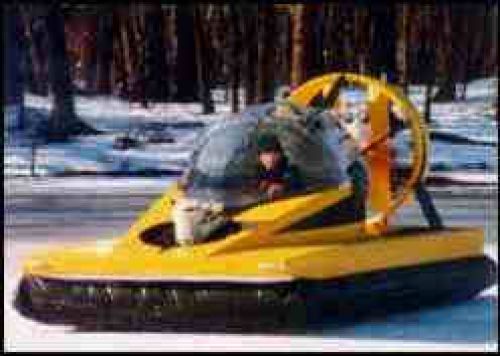 The 12T4 from
Universal Hovercraft
Hovercrafts are amazing vehicles that levitate above the ground using air
pressure. Since they don't touch the ground you can pretty much drive over
anything. Our model, the 12T4, hovers 8" over the ground and can carry 2 people
at a top speed of 40mph. The frame of the craft or "skeleton" is composed of 7
width-wise "ribs" numbered starting from the front, and numerous 3/4"
"stringers" that run length-wise to hold it all together. The frame is covered
in a "skin" of 1/8" plywood (expensive and very hard to find). The "skirt" is a
heavyweight coated nylon that surrounds the bottom of the craft and holds in the
air. It is powered by two lawn mower style engines.
So, I ordered the plans for $29.95, and scouted out some help;
Ruppert
my German roommate, and
Blaine
my next door neighbor and thatís where it all started.
The 12T4 from
Universal Hovercraft
Hovercrafts are amazing vehicles that levitate above the ground using air
pressure. Since they don't touch the ground you can pretty much drive over
anything. Our model, the 12T4, hovers 8" over the ground and can carry 2 people
at a top speed of 40mph. The frame of the craft or "skeleton" is composed of 7
width-wise "ribs" numbered starting from the front, and numerous 3/4"
"stringers" that run length-wise to hold it all together. The frame is covered
in a "skin" of 1/8" plywood (expensive and very hard to find). The "skirt" is a
heavyweight coated nylon that surrounds the bottom of the craft and holds in the
air. It is powered by two lawn mower style engines.
So, I ordered the plans for $29.95, and scouted out some help;
Ruppert
my German roommate, and
Blaine
my next door neighbor and thatís where it all started.
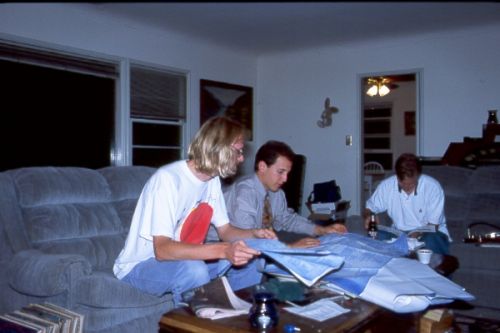 The total cost of building this thing was $2000 and we built it over a period of
about 9 months. Here are some Photos From the project in progress. We had a
great time doing it and learned a lot about ruining clothes. We even got an
article in the Santa Barbara News Press about it, and a spot on a local Spanish
television broadcast.
Santa Barbara News Press Article
The total cost of building this thing was $2000 and we built it over a period of
about 9 months. Here are some Photos From the project in progress. We had a
great time doing it and learned a lot about ruining clothes. We even got an
article in the Santa Barbara News Press about it, and a spot on a local Spanish
television broadcast.
Santa Barbara News Press Article
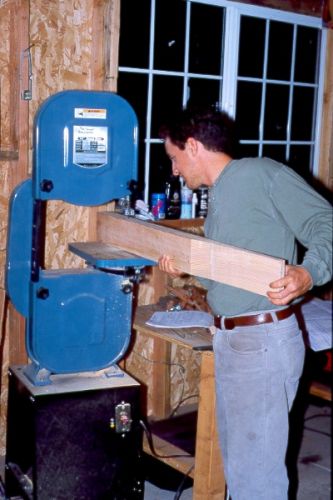 The Lift Fan after being laminated, dimensioned, and rough-cut
The Lift Fan after being laminated, dimensioned, and rough-cut
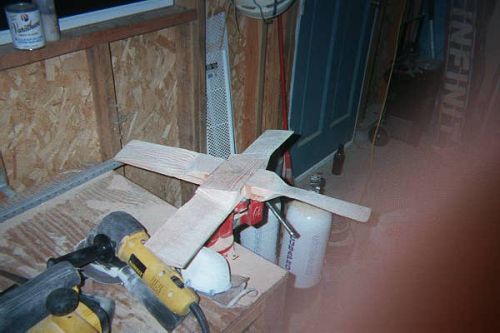 A precise airfoil profile is important for high performance.
A precise airfoil profile is important for high performance.
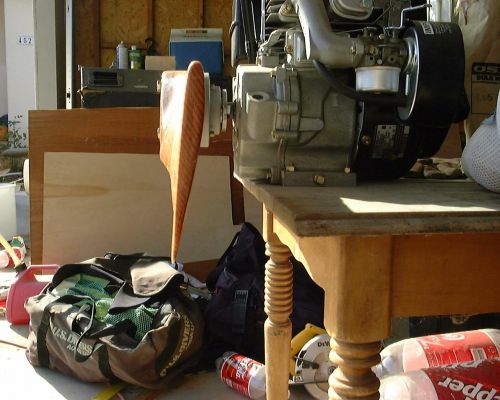 The finished Thrust Prop mounted to a 10hp Tecumseh (piece of shit) lawn mower
engine.
The finished Thrust Prop mounted to a 10hp Tecumseh (piece of shit) lawn mower
engine.
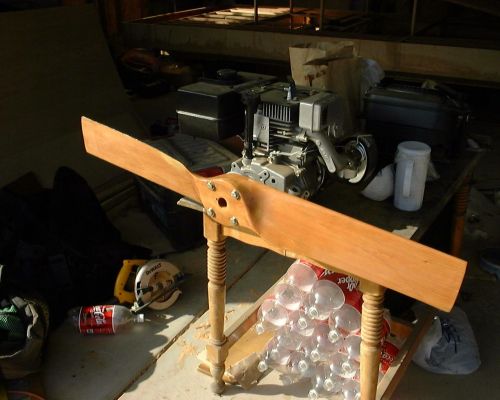 The finished Lift Fan waiting to be mounted to a 6hp Briggs And Stratton lawn
mower engine.
The finished Lift Fan waiting to be mounted to a 6hp Briggs And Stratton lawn
mower engine.
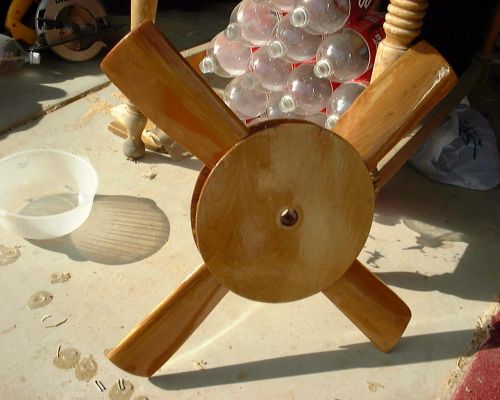 Both finished propellers...
Both finished propellers...
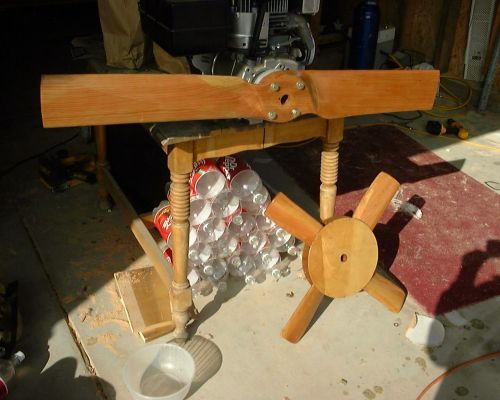 Who needs to dust out the garage if you have one of these. Although other things
that accidentally get sucked up are generally destroyed.
Who needs to dust out the garage if you have one of these. Although other things
that accidentally get sucked up are generally destroyed.
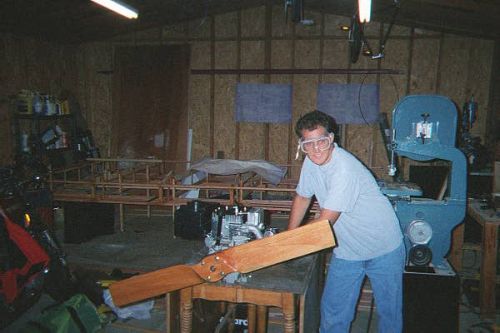
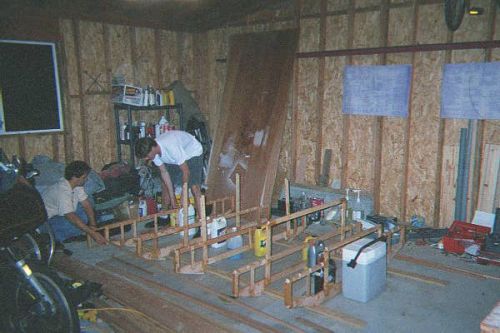 The frame is starting to take shape. Here we are laying out plywood to get an
idea as to the shape of the bottom of the craft.
The frame is starting to take shape. Here we are laying out plywood to get an
idea as to the shape of the bottom of the craft.
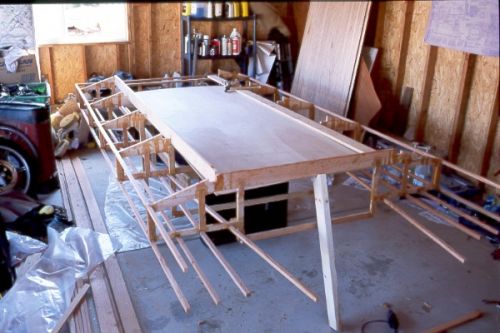 Putting 1/8" plywood on the bottom of the craft with epoxy. Two part epoxy is a
good way to permanently ruin your clothes.
Putting 1/8" plywood on the bottom of the craft with epoxy. Two part epoxy is a
good way to permanently ruin your clothes.
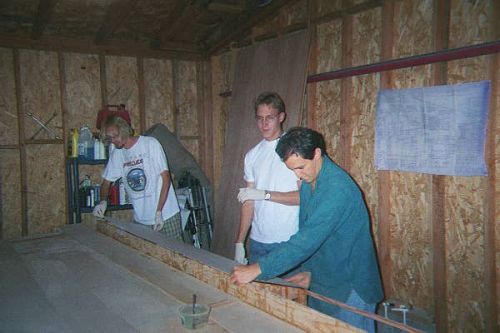 Here, the bottom skin has been attached and the seams have been fiberglassed.
The bottom is (hopefully) waterproof by now.
Here, the bottom skin has been attached and the seams have been fiberglassed.
The bottom is (hopefully) waterproof by now.
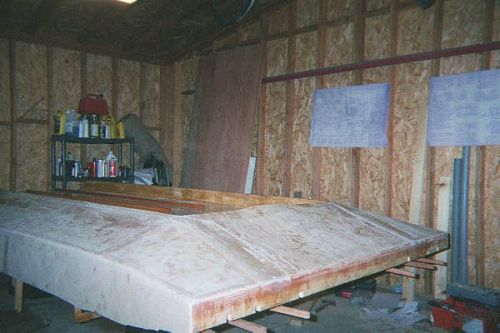 Here I am, sanding the inside of the craft.
Here I am, sanding the inside of the craft.
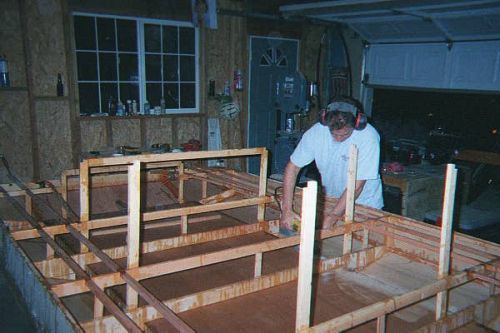 Looking forward at Ribs 1, 2, 3, and 4.
Looking forward at Ribs 1, 2, 3, and 4.
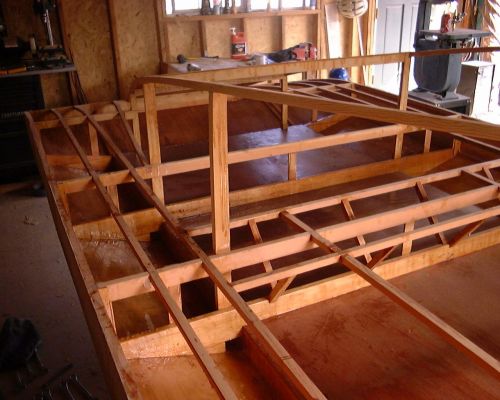
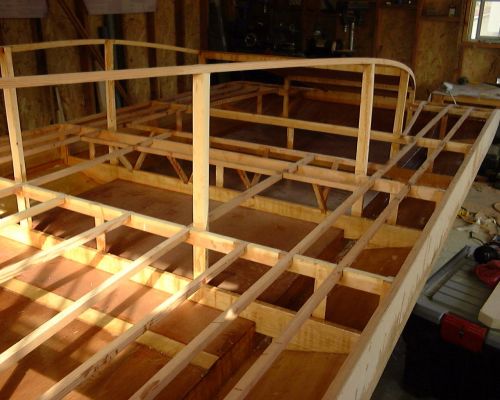 Rib 4 which will eventually become our seat.
Rib 4 which will eventually become our seat.
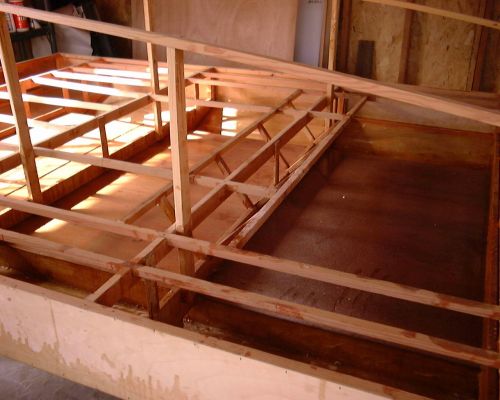 Looking back at Ribs 5, 6, and 7.
Looking back at Ribs 5, 6, and 7.
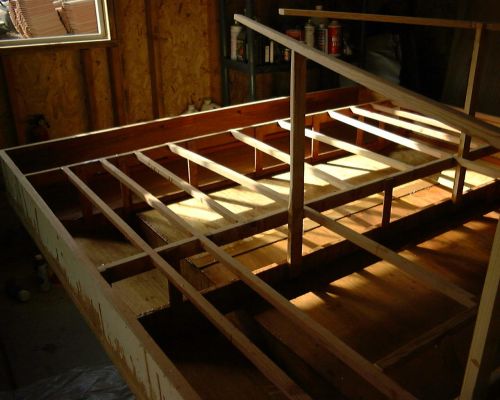 Skeleton complete and waiting for the Lift Duct to be installed.
Skeleton complete and waiting for the Lift Duct to be installed.
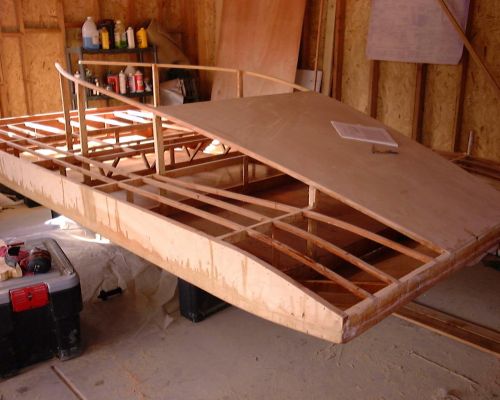
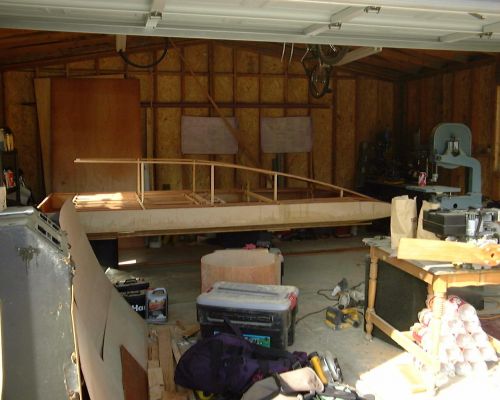 The Lift Duct being formed using the sides of an old table cut into two discs.
The Lift Duct being formed using the sides of an old table cut into two discs.
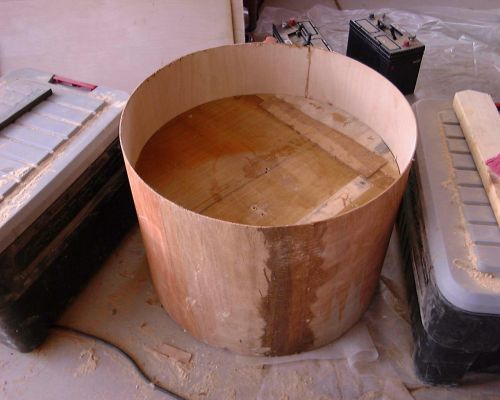 The Lift Duct installed! The milk jugs are for emergency floatation.
The Lift Duct installed! The milk jugs are for emergency floatation.
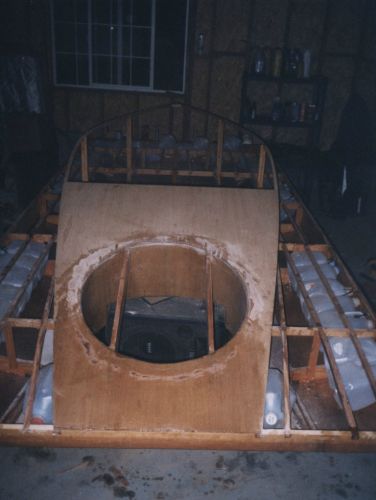
 The steering rudders are made from foam and fiberglass, just like a surf board.
Here they are waiting to be painted.
The steering rudders are made from foam and fiberglass, just like a surf board.
Here they are waiting to be painted.
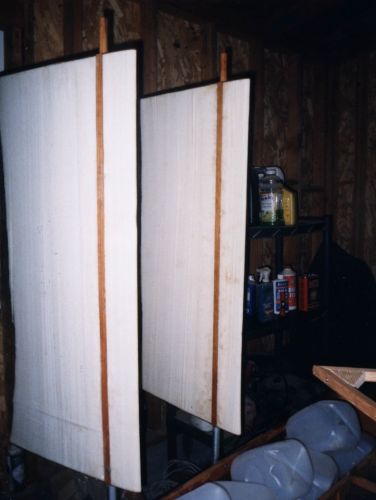 The aerodynamic profile was cut with a hot (warm) wire.
The aerodynamic profile was cut with a hot (warm) wire.
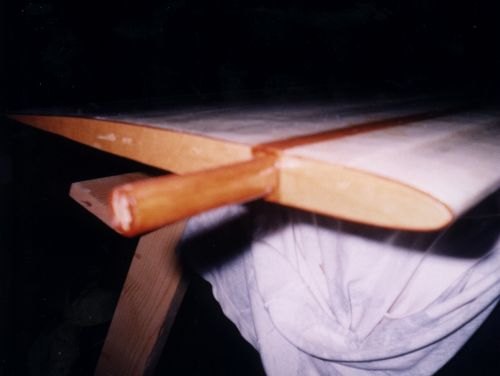 Here the steering hardware waits to be installed.
Here the steering hardware waits to be installed.
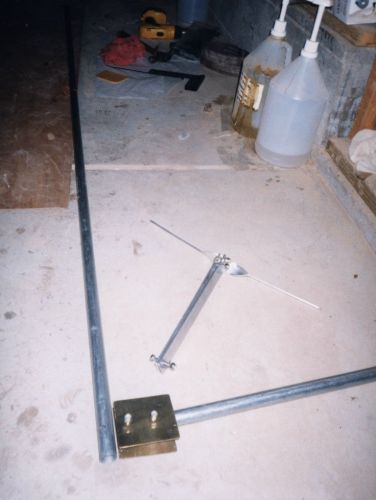 We picked up a trailer for $80 and spent a week modifying it.
We picked up a trailer for $80 and spent a week modifying it.
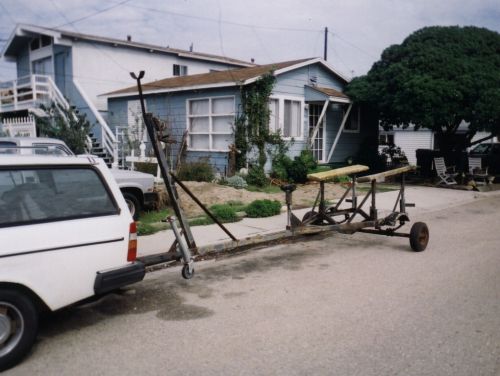 On it's way to National Autobody And Paint to get painted. (Thanks Joe!)
On it's way to National Autobody And Paint to get painted. (Thanks Joe!)
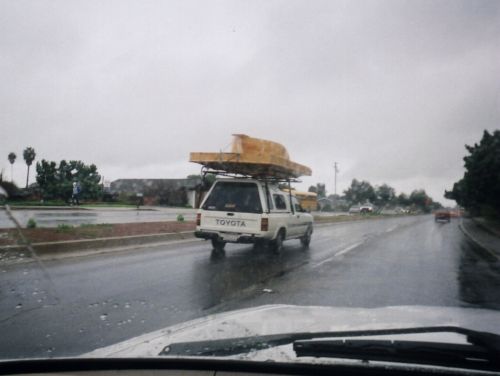 The paint job was a success!
The paint job was a success!
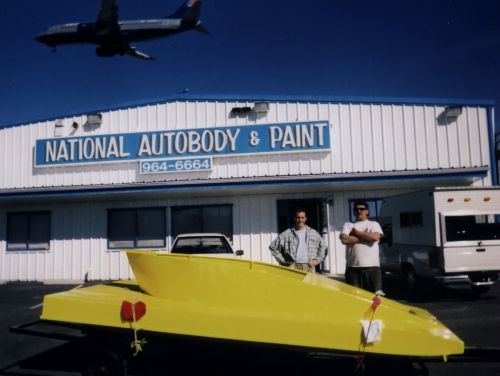 The three blind mice take a moment to admire their work.
The three blind mice take a moment to admire their work.
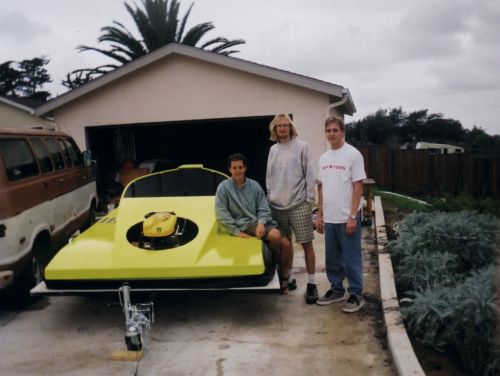 Craft near completion with lift and thrust engines mounted on 'new' trailer.
Craft near completion with lift and thrust engines mounted on 'new' trailer.
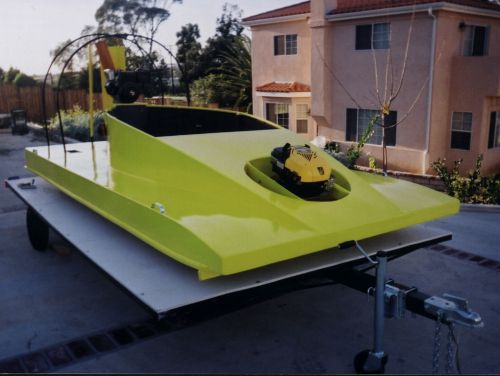
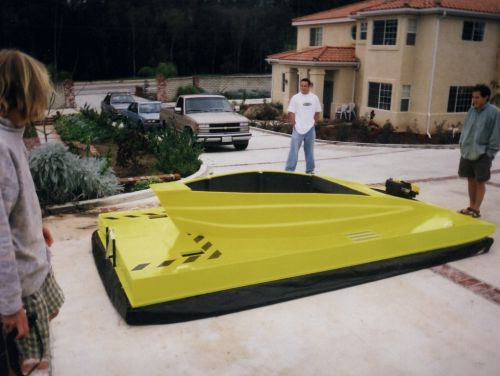 IT WORKS!!!
IT WORKS!!!
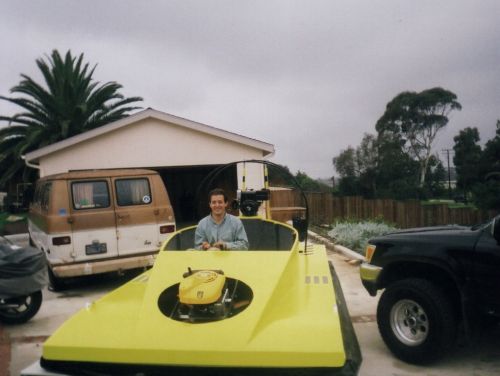 Successful maiden voyage at Lake Nacimiento. I only hit 1 tree!
Successful maiden voyage at Lake Nacimiento. I only hit 1 tree!
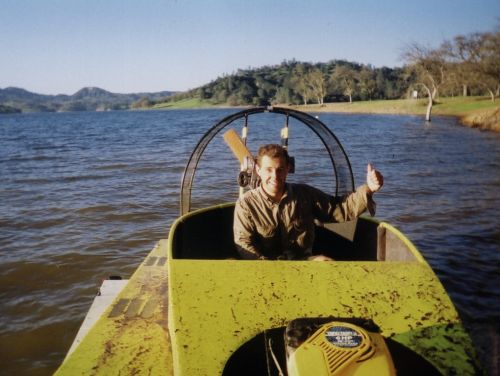
| Date | Location | Description |
| 03/07/00 |
|
Very first trial and the thing worked. We were running out of daylight and needed someplace to test out both engines simulataneously so we set up in the parking lot of the high school across the street. We did not have a throttle for the thrust yet so one person steered while the other pulled the bicycle cable that controlled the thrust engine. We were all shocked to see it hover and accelerate for the first time. It moved over speed bumps and those cement blocks in front of parking spaces like they were not even there. We also decided that braking is definetly a very significant issue so engine cutoff switches will be needed. We kicked up a lot of gravel and dirt. Dirt gets everywhere, inside the craft your hair, ears, everywhere. The key here is to find surfaces that do not have as much gravel. |
| 03/28/00 |
|
The Santa Barbara Newspress came out to do an article. UCSB was on spring break so we decided to try out Stork Field by Harder Stadium. The craft moved slugishly on grass. On grass air may be leaking through the blades of grass. We all took turns, including Rupert, Daryl, the reporter, cameraman, and myself. The article can be found here, Santa Barbara News Press Article |
| 03/30/00 |
|
Telemundo Channel 47 contacted us on doing an article for their news channel. We went out to Storke Field again. The guy on the tractor cutting the field was nice enough to stand by for a few minutes. The hovercraft moves at maybe 25mph on this grass. The news segment appeared on TV in spanish, I need to digitize it or get a translator. The camera man didn't speak english very well but that was cool because driving the hovercraft is pretty simple when there's nothing to run into. |
| 04/01/00 |
|
We arrived at Lake Cachuma on April Fools day of all
days and were not let in the park. That day we were told that the craft "had
to be certified by the Coast Guard to enter the park." So the parks people
cried about Lake Cachuma being safe by not letting people touch the water and
bla bla. But the craft does have a CF number and HIN(kinda like a VIN for your
car) from the DMV. I went through the laws put up by the Coast Guard and
confirmed over many phone calls that our hovercraft does meet all boating
regulations. What could be safer for a lake then something that does not touch
the water? So Lake Cachuma would not let us on the resevoir because the bass
fisherman were jelous that they didn't have such a cool boat. Acutally County
Parks rule 2687c states something like to operate on a lake the craft must be
determined to be of standard design as determined by the director or a deputy
for canoes, cayaks, rafts, and/or inflatables. In a nut shell anybody dressed
up in a funny hat can do whatever they want. We all disagree with this and
encourage y'all to flame the director by writing to: Cachuma Lake HC 58 Santa Barbara, Ca 93105 |
| 04/02/00 |
|
We tested the engine by dousing it with water then spraying the engines with salt water. So we went off to the beach with high hopes. We encountered the same problems with salt water as the day before. However the problems were less severe as we encapsulated the spark plugs in thicker rubber boots. It was a bit embarassing to draw a crowd then get it stuck in water and take 10 minutes yanking cords to restart the engines. |
| 04/07/00 | Goleta Beach | The craft now works fine over salt water. We insulated all electrical contacts with silicon gel. It was a bit nerve racking to see it hover for the first time over the ocean but it never cut out. I learned how not to maneuver the craft by trying to drive through an inlet and running into the cliff. A hole was punctured into the bottom of the craft. It is now reparied to where that part of the hull is a bit stronger. We let some random UCSB engeineering student try it out then Daryl took out a guy with his 9-year old son. He then emailed Daryl to say that his 9-year old son has been putting lego hovercrafts together ever since that day. |
| 04/09/00 |
|
Had a nice day at the beach for a few hours. We gave rides to a lot of friends in the Henchmyn band. Unfortunately some student drivers got a little too close to the beach goers and a county parks guy was there to tell us to take the hovercraft home. That and Daryl scaring several hundred birds in the air ruined our welcome. It is pretty amazing every time the hovercraft goes from land to water - almost like watching someone walk on water. |
| 04/14/00 |
|
KEYT Channel 3 came out to film us at the beach. We got it running on a foggy day with low tide. It runs very fast on wet sand. Daryl was driving pretty fast along the wet sand and thought he could make it between the columns of the Goleta Pier. Well it was great for the camera up to the point where Daryl decided that wasn't a good idea and turned around. But the the craft was moving too fast and did not slow down in time before bumping into the pier. And once again the County Parks guy was there to advise us to get insurance before returning. The incident with the pier scratched up the lift prop and the lift engine mount. The lesson here is to be more careful when on smooth surfaces. |